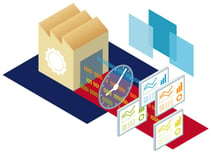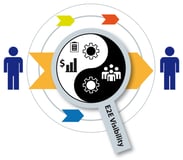What Is Supply Chain Integration?
Brian Hoey - April 16, 2020

 We’ve sung the praises of supply chain integration at this blog on more than one occasion, and we’re certainly not the only ones who are willing to speak to its virtues. After all, a recent report found that fully-integrated businesses outperform their non-integrated competitors in terms of revenue by 20% on average. Even the integration of individual processes into a digital framework can make a big difference—one study even found that integrating a previously manual workflow like inventory tracking into a digital framework boosted productivity by 25%, while improving use of space and efficiency.
We’ve sung the praises of supply chain integration at this blog on more than one occasion, and we’re certainly not the only ones who are willing to speak to its virtues. After all, a recent report found that fully-integrated businesses outperform their non-integrated competitors in terms of revenue by 20% on average. Even the integration of individual processes into a digital framework can make a big difference—one study even found that integrating a previously manual workflow like inventory tracking into a digital framework boosted productivity by 25%, while improving use of space and efficiency.
Sometimes, though, in all of the excitement about its potential benefits, articles will forget to cover the basic building blocks of the concept, i.e. what supply chain integration is and how it can be made a reality. Even if the concept might seem obvious, it’s often helpful to have a quick refresher or a point of reference—that way, you can be sure that you’re not talking and strategizing at cross-purposes with other stakeholders when you take steps to build a smarter, more integrated supply chain.
Supply Chain Integration Defined
So, first things first, what is supply chain integration? At an extremely high level, the “integration” here refers to integrating your operation, your employees, your suppliers and supply chain partners, and sometimes even your customers into the supply chain ecosystem. This will typically involve the adoption of some shared IT infrastructure, whether that means adopting the same platform or utilizing a Postmodern ERP approach to connect data streams from multiple different platforms.
To get more specific, integration is typically divided up into two categories:
- Vertical integration involves connecting with suppliers, distributors, and other partners up or downstream in the supply chain. This can help you boost visibility into things like sourcing and transport planning, thereby putting you in a position to reduce costs and avoid disruptions.
- Horizontal integration is often a less obvious use case for supply chain management, but it would theoretically involve integration with another manufacturer in order to gain flexibility. This might lead to a given business strategically sharing warehouses or yards with another company on the same ‘rung’ of the supply chain, or buying raw materials in bulk to get a better rate from suppliers.
In some supply chains, you see a combination of these two forms of integration, known as ‘vertizontal’ integration, which ostensibly offers synergy between the two forms of integration. On both (or, rather, all three) of these paradigms, however, the implementation will look fairly similar. Depending on your software environment, you’ll either urge your partner organizations to get licenses for a platform you’re already using, or you’ll adopt a separate platform that speaks specifically to the needs of the all the involved stakeholders. Either way, you’ll share data via this platform, and that data will be accessible throughout your operation via some sort of centralized system designed to prevent silos and Shadow IT. From there, when you need to know the availability of a particular part, or your estimated transport costs for a particular cargo, you can simply check into your digital platform and find out in seconds, rather than waiting for your partner to return a phone call or an email.
From Integration to Optimization
While integration can be a valuable tool for boosting productivity and decreasing costs, its true value lies in the way its leveraged by other processes. To wit, a procurement manager who uses integration to gain live data from her suppliers is less likely to get blindsided by outages or hidden—but if that same procurement manager had integrated advanced analytics into those data streams in order to create smart predictions for future sourcing conditions, she’d stand poised to add even more value. For instance, she might see a shortage coming weeks in advance and shore up her buffer stock as a precaution. She would collaborate with her partners in inventory management to make sure the space could be utilized efficiently, and this data would be made available to production planners who could, in turn, use their own analytics to create the optimal production ratios for the current market conditions.
In this way, integration gives analytics-enabled workflows the tools to drive towards supply chain optimization. And it doesn’t have to stop with analytics. An integrated supply chain software environment might empower you to integrate additional elements like IoT (internet of things) devices or smart containers and pallets. With this kind of technology in tow, you can begin to visualize your entire supply stream in real-time, making data-driven adjustments and replannings to preserve value as new conditions arise.
Challenges in Supply Chain Integration
Of course, successful supply chain integration is often easier said than done. While the benefits certainly outweigh the potential infrastructure investments and person-hours spent perfecting your integrated supply chain environment, there will inevitably be challenges along the road—just as there will inevitably be disruptions that integration can help you overcome. What are some of those challenges? Well, they might take different forms:
- Resistance to new software within your own or your partners’ operations;
- Selecting a platform that doesn’t prevent silos, and that can’t be scaled up to power analytics usage in the future;
- Poor visibility as a result of sub-par implementation (e.g. silos arising because of low adoption rates among stakeholders, etc.)
- Lackluster integration of analytics workflows due to silos elsewhere in your IT ecosystem.
Based on these challenges, we hope that you’re getting a sense of how important it is to have a frank discussion with stakeholders so that you can collectively choose the right technology to deploy. If you can do this, and if you can leverage internal campaigns and communications to demonstrate the value of integration to your employees, you can implement supply chain integration pretty smoothly. If, on the other hand, you wind up with a software platform that doesn’t work for its primary users, you may be stuck with sub-par data visibility and few operational benefits. Luckily, this pitfall can be easy to avoid if you approach new technology with the right questions and the right mindset.
LATEST POSTS
- Understand Why Production Planning Needs Specialized Solutions
- Understand Circular Economy in The Manufacturing Industry
- How Can Industry 4.0 IT Integration Be Achieved Smoothly?
- The Significance of Order Sequencing in Discrete Manufacturing
- How to improve your Supply Chain Management: The Power of Control Towers



